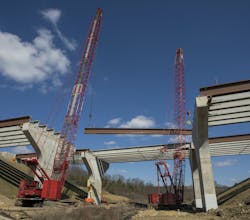Two cranes collaborate to set bridge for brand new Pittsburgh highway
As a certain saying reminds us, functioning smoothly and efficiently requires the left hand to know what the right hand is doing. So imagine how critical it is for two cranes to work together seamlessly when combining efforts on a pick. Such was the case on a 13-mile phase of the colossal Southern Beltway highway project currently under construction in Greater Pittsburgh.
Two cranes had to work in tandem precision to lift and set concrete beams, each 125 ft long and weighing 73 tons, for one of the Southern Beltway’s new bridges. This particular bridge, identified by the project section number 55A1, carries the Beltway, also known as S.R. 576, over Little Raccoon Creek.
The Southern Beltway is a rarity in road construction: the building of a brand new highway. Not just a widening or repair job, it is completely original construction—so complex it is being built in multiple stages. When the new 13-mile middle segment of the Beltway is complete, it will join I-79 to Rte. 22.
Joe Schrecengost of Alvarez Inc., a specialty trade contractor for heavy highway bridge construction, was the erection supervisor on the job. He used a 300-USt Manitowoc 2250 and a 380-USt Manitowoc MLC300, both from ALL Crane Rental of Pennsylvania, a member of the ALL Family of Companies. An ALL operator was inside the MLC300, and a good friend of Schrecengost’s operated the 2250.
“A lot of times, one of the cranes was at a much lower elevation, so they couldn’t see each other. We had to rely on radio communication. I had radios in both crane compartments on each pier—a half-dozen sets of eyes total. The cranes had to hoist these bridge sections 90 ft in the air and walk them into position,” said Schrecengost.
The delicate process required actions to be repeated with sterling precision. A beam on a flatbed would be backed up to crane No. 1 sitting on the west side of the creek. The operator would pick one end of the beam off the truck dolly and swing to his left toward crane No. 2 on the other side of the creek.
As the operator was doing that, the flatbed—which still had one end of the beam on it—had to start backing up. The crane operator was tasked with coordinating its movement to go the same speed as the truck. Once the crane reached to the allowable radius, it would stop.
Crews then used a lifting triangle that allowed for passing one end of the beam in midair to the second crane on the other side of the creek. Once the beam was passed off to crane No. 2, crane No. 1 was unhooked, would swing back around and get hooked to the other end of the beam sitting on the flatbed. No. 1 lifted that end of the beam into the air, and then both cranes would be holding the beam aloft.
“At this point, it became critical that we coordinate both cranes lifting—one swinging to its right, the other to its left—as they set the beam onto the pad,” explained Schrecengost. “Once it was set, we used half-inch chain and chain binders attached to brackets and mounted on the bridge abutment and the bridge piers to hold the beams up.”
This process was repeated 42 times to set beams for the entire bridge span. Due to the northeast’s volatile spring season, completion took three weeks.
As might be expected, months of preliminary work went into making sure the job went safely and smoothly, and ALL Crane’s 3-D modeling capability was key to ensuring that for Alvarez.
